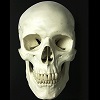2.4: Landmarks and Measurements of the Skull
- Page ID
- 11432
Standardized landmarks and measurements of the skull and post-cranium are necessary in order to compare validity as part of the scientific method. These measurements can be used to determine sex, biological affinity, stature, modernity, and specific facial features in the remains of an unknown individual. Therefore, it is necessary to use agreed upon landmarks on the skull from which the measurements can be taken. To increase reliability, an individual researcher should take the same measurements on an individual(s) several times over the course of a few days to estimate intra-observer error. Research partners should undertake the same process to determine what the error rate may be between researchers, inter-observer error. The following list of landmarks and basic measurements will aid in learning standardized methodology used in osteological research.
Landmarks
Alveolare - The bony crest located between the central maxillary incisors.
Alare - Determined using sliding calipers placed on the most lateral margins of the nasal aperture.
Basion - Point located on the anterior border of the foramen magnum.
Bregma - The point where the sagittal suture meets the coronal suture anteriorly.
Dacryon - Located in the medial aspect of the orbits, the point where the maxilla, lacrimal, and frontal meet.
Ectoconchion - Located at the intersection of the frontal and zygomatic, on the medial aspect.
Euryon - Determined using spreading calipers placed on the posterior parietals at the greatest breadth.
Frontotemporale - Located on each of the temporal lines of the frontal in the area of greatest constriction.
Glabella - The point superior to the nasal bones, between the supraorbital ridges.
Gnathion - The central point on the infereior aspect of the mandibular body in the region of the mental eminence.
Infradentale - The bony crest located between the mandibular central incisors.
Lambda - The intersection point of the lambdoiadal suture and the sagittal suture.
Nasion - The point located most superiorly where the nasal bones meet.
Nasiospinale - The point where the midsagittal plane intersects the inferior margin of the nasal aperture.
Opisthion - The most medial point on the posterior aspect of the foramen magnum.
Opisthocranion - Most posterior aspect of the skull , excluding the area around the external occipital protuberance.
Orbitale - The most inferior point on the lower orbital margin.
Prosthion - On the upper alveolar process, this is the most anterior point at midline.
Zygoin - Determined using spreading calipers placed on the most lateral aspects of the zygomatic arches.
Measurements
Basion-Bregma - Taken using the spreading calipers; one end of the calipers is placed on the medial aspect of the rim of the foramen magnum (basion) and the other end is placed at intersection of the coronal and sagittal sutures (bregma).
Bizygomatic - Taken using psreading calipers; one end of the calipers goes to the most lateral aspect of each of the zygomatic arches (zygoma to zygoma).
Cranial breadth - Taken using the spreading calipers; one end of the calipers goes to the most lateral aspect of each of the parietals (euryon to euryon).
Cranial length - Take using the spreading calipers; one end of the calipers is placed just superior to the frontonasal suture on the most anterior aspect of the frontal (glabella), while the other is placed at the most posterior aspect of the skull (opisthocranion).
Minimum frontal breadth - Taken using the spreading calipers; one end of the calipers is placed on each of the temproal lines of the frontal in the area of greatest constriction (frontotemporale to frontotemporale).
Nasal breadth - Measurement is taken from alare to alare, to obtain the maximum breadth; use spreading calipers.
Nasal height - Measurement is taken from nasion to nasiospinale; use sliding calipers.
Orbital breadth - Measurement is taken from dacryon to extoconchoin; use spreading calipers.
Orbital height - Measurement is taken perpendicular to the hoziontal axis of the orbit; use spreading calipers.
Total facial height - Measurement is taken from nasion to gnathion with teeth in occlusion; use sliding calipers.
Upper facial height - Measurement is taken nasion to alveolare (does not include height of the mandible); use sliding caliplers.


